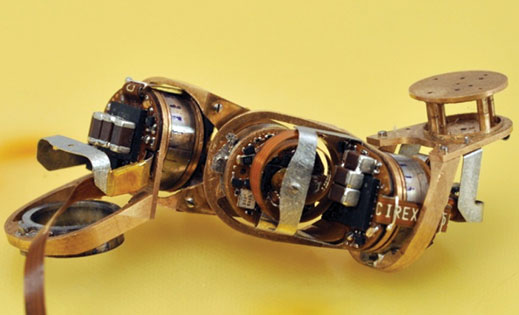The Swiss Army Knife Robot
A little device that resembles a mechanical inchworm could usher in a new generation of robots that can fold themselves up into almost any shape imaginable—a diminutive real-life version of the robots in the Transformers movies.

The device is called a milli-motein—a reference to its millimeter-sized components and a motorized design inspired by proteins, which naturally fold themselves into incredibly complex shapes. “It’s effectively a one-dimensional robot that can be made in a continuous strip, without conventionally moving parts, and then folded into arbitrary shapes,” says Neil Gershenfeld, head of MIT’s Center for Bits and Atoms, who created the device with visiting scientist Ara Knaian and postdoctoral associate Kenneth Cheung.
To build it, the research team had to invent an entirely new kind of motor: one that is not only small and strong but also able to hold its position firmly even with the power switched off. (When an ordinary electric motor is switched off, its shaft can rotate freely.) The researchers met these needs with a new system called an electropermanent motor.
It’s part of an overall approach to “turning data into things,” Gershenfeld explains. The milli-motein is part of a family of such devices being explored at various sizes, from protein-based “nanoassemblers” to a version in which each link in the chain of modules is as big as a person, Gershenfeld says.
Ultimately, a reconfigurable robot should be “small, cheap, durable, and strong,” Knaian says, adding that right now “it’s not possible to get all of those.” Still, he points out, proteins and other molecules that form the basis of living organisms do have all of those qualities. “Biology is the existence proof that it is possible,” he says.
Keep Reading
Most Popular
Large language models can do jaw-dropping things. But nobody knows exactly why.
And that's a problem. Figuring it out is one of the biggest scientific puzzles of our time and a crucial step towards controlling more powerful future models.
The problem with plug-in hybrids? Their drivers.
Plug-in hybrids are often sold as a transition to EVs, but new data from Europe shows we’re still underestimating the emissions they produce.
Google DeepMind’s new generative model makes Super Mario–like games from scratch
Genie learns how to control games by watching hours and hours of video. It could help train next-gen robots too.
How scientists traced a mysterious covid case back to six toilets
When wastewater surveillance turns into a hunt for a single infected individual, the ethics get tricky.
Stay connected
Get the latest updates from
MIT Technology Review
Discover special offers, top stories, upcoming events, and more.